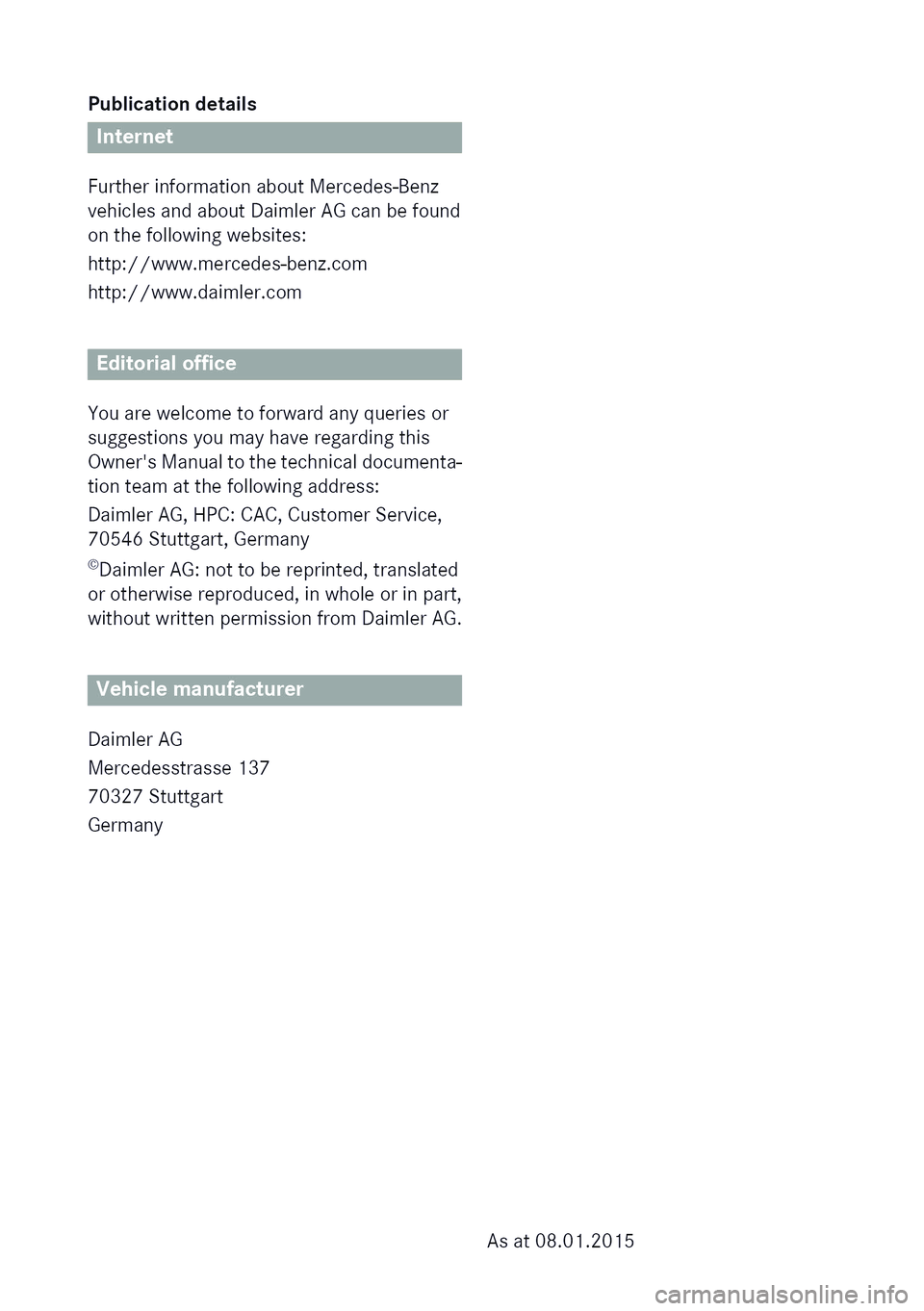MERCEDES-BENZ CLA SHOOTING BRAKE 2015 Owners Manual
Manufacturer: MERCEDES-BENZ, Model Year: 2015, Model line: CLA SHOOTING BRAKE, Model: MERCEDES-BENZ CLA SHOOTING BRAKE 2015Pages: 421, PDF Size: 12.52 MB
Page 411 of 421
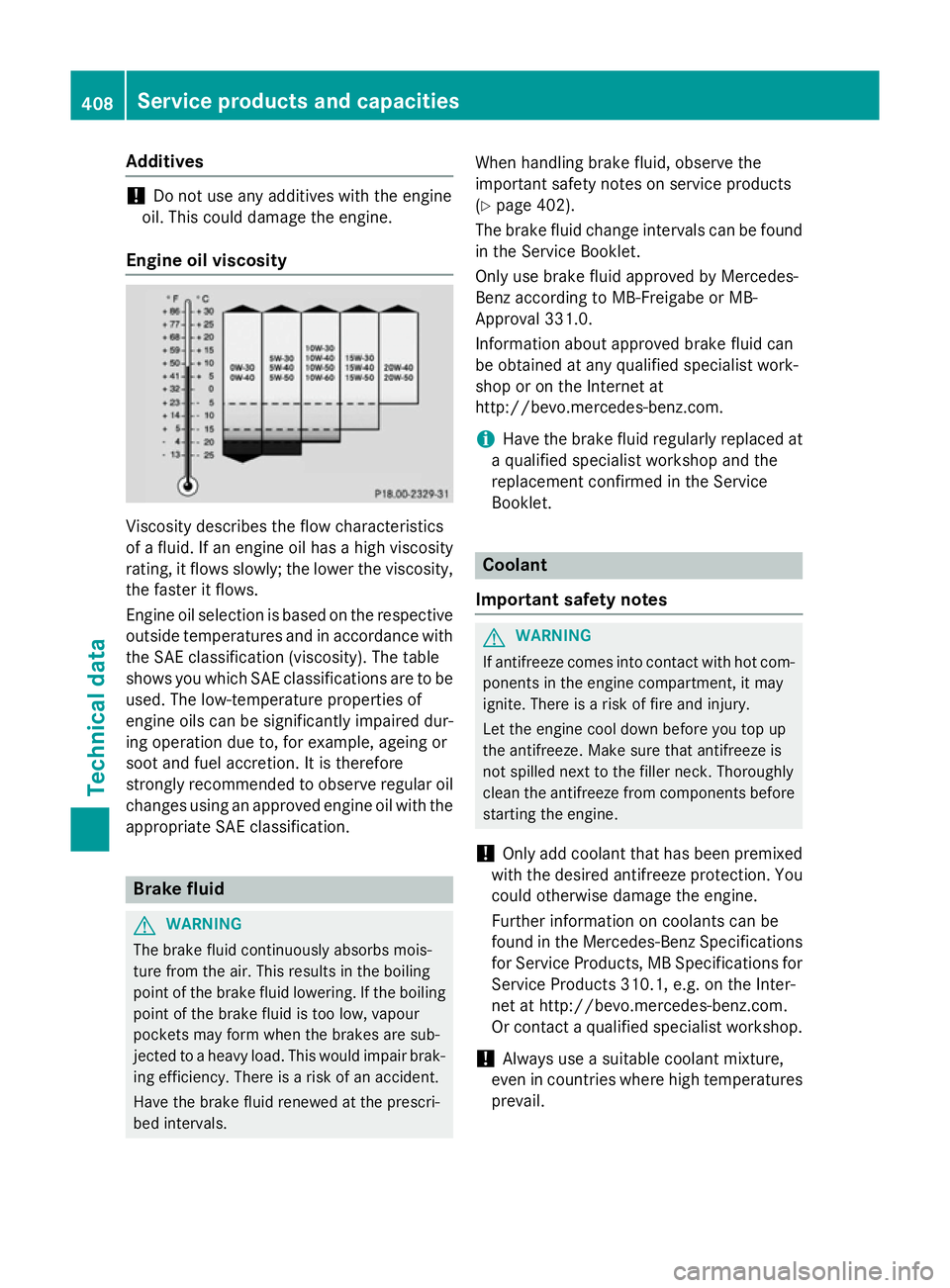
Additives
!
Do not use any additives with the engine
oil. This could damage the engine.
Engine oil viscosity Viscosity describes the flow characteristics
of a fluid. If an engine oil has a high viscosity
rating, it flows slowly; the lower the viscosity,
the faster it flows.
Engine oil selection is based on the respective outside temperatures and in accordance with
the SAE classification (viscosity). The table
shows you which SAE classifications are to be
used. The low-temperature properties of
engine oils can be significantly impaired dur-
ing operation due to, for example, ageing or
soot and fuel accretion. It is therefore
strongly recommended to observe regular oil changes using an approved engine oil with the
appropriate SAE classification. Brake fluid
G
WARNING
The brake fluid continuously absorbs mois-
ture from the air. This results in the boiling
point of the brake fluid lowering. If the boiling
point of the brake fluid is too low, vapour
pockets may form when the brakes are sub-
jected to a heavy load. This would impair brak- ing efficiency. There is a risk of an accident.
Have the brake fluid renewed at the prescri-
bed intervals. When handling brake fluid, observe the
important safety notes on service products
(Y page 402).
The brake fluid change intervals can be found in the Service Booklet.
Only use brake fluid approved by Mercedes-
Benz according to MB-Freigabe or MB-
Approval 331.0.
Information about approved brake fluid can
be obtained at any qualified specialist work-
shop or on the Internet at
http://bevo.mercedes-benz.co m.
i Have the brake fluid regularly replaced at
a qualified specialist workshop and the
replacement confirmed in the Service
Booklet. Coolant
Important safety notes G
WARNING
If antifreeze comes into contact with hot com- ponents in the engine compartment, it may
ignite. There is a risk of fire and injury.
Let the engine cool down before you top up
the antifreeze. Make sure that antifreeze is
not spilled next to the filler neck. Thoroughly
clean the antifreeze from components before
starting the engine.
! Only add coolant that has been premixed
with the desired antifreeze protection. You
could otherwise damage the engine.
Further information on coolants can be
found in the Mercedes-Benz Specifications for Service Products, MB Specifications for Service Products 310.1, e.g. on the Inter-
net at http://bevo.mercedes-benz.com.
Or contact a qualified specialist workshop.
! Always use a suitable coolant mixture,
even in countries where high temperatures prevail. 408
Service products and capacitiesTechnical data
Page 412 of 421
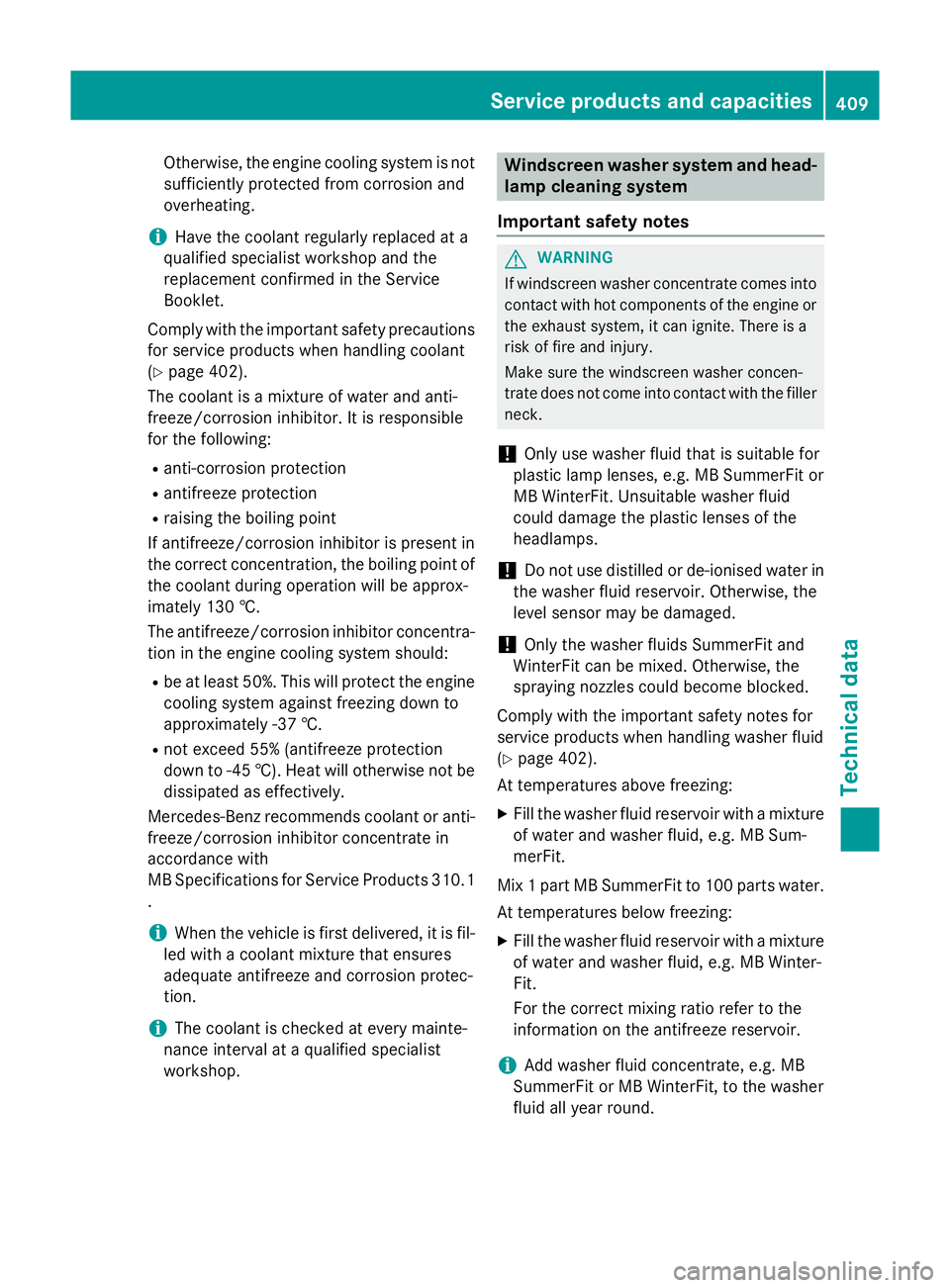
Otherwise, the engine cooling system is not
sufficiently protected from corrosion and
overheating.
i Have the coolant regularly replaced at a
qualified specialist workshop and the
replacement confirmed in the Service
Booklet.
Comply with the important safety precautions for service products when handling coolant
(Y page 402).
The coolant is a mixture of water and anti-
freeze/corrosion inhibitor. It is responsible
for the following:
R anti-corrosion protection
R antifreeze protection
R raising the boiling point
If antifreeze/corrosion inhibitor is present in
the correct concentration, the boiling point of
the coolant during operation will be approx-
imately 130 †.
The antifreeze/corrosion inhibitor concentra- tion in the engine cooling system should:
R be at least 50%. This will protect the engine
cooling system against freezing down to
approximately -37 †.
R not exceed 55% (antifreeze protection
down to -45 †). Heat will otherwise not be
dissipated as effectively.
Mercedes-Benz recommends coolant or anti- freeze/corrosion inhibitor concentrate in
accordance with
MB Specifications for Service Products 310.1
.
i When the vehicle is first delivered, it is fil-
led with a coolant mixture that ensures
adequate antifreeze and corrosion protec-
tion.
i The coolant is checked at every mainte-
nance interval at a qualified specialist
workshop. Windscreen washer system and head-
lamp cleaning system
Important safety notes G
WARNING
If windscreen washer concentrate comes into contact with hot components of the engine or
the exhaust system, it can ignite. There is a
risk of fire and injury.
Make sure the windscreen washer concen-
trate does not come into contact with the filler neck.
! Only use washer fluid that is suitable for
plastic lamp lenses, e.g. MB SummerFit or
MB WinterFit. Unsuitable washer fluid
could damage the plastic lenses of the
headlamps.
! Do not use distilled or de-ionised water in
the washer fluid reservoir. Otherwise, the
level sensor may be damaged.
! Only the washer fluids SummerFit and
WinterFit can be mixed. Otherwise, the
spraying nozzles could become blocked.
Comply with the important safety notes for
service products when handling washer fluid
(Y page 402).
At temperatures above freezing:
X Fill the washer fluid reservoir with a mixture
of water and washer fluid, e.g. MB Sum-
merFit.
Mix 1 part MB SummerFit to 100 parts water.
At temperatures below freezing:
X Fill the washer fluid reservoir with a mixture
of water and washer fluid, e.g. MB Winter-
Fit.
For the correct mixing ratio refer to the
information on the antifreeze reservoir.
i Add washer fluid concentrate, e.g. MB
SummerFit or MB WinterFit, to the washer
fluid all year round. Service products and capacities
409Technical data Z
Page 413 of 421
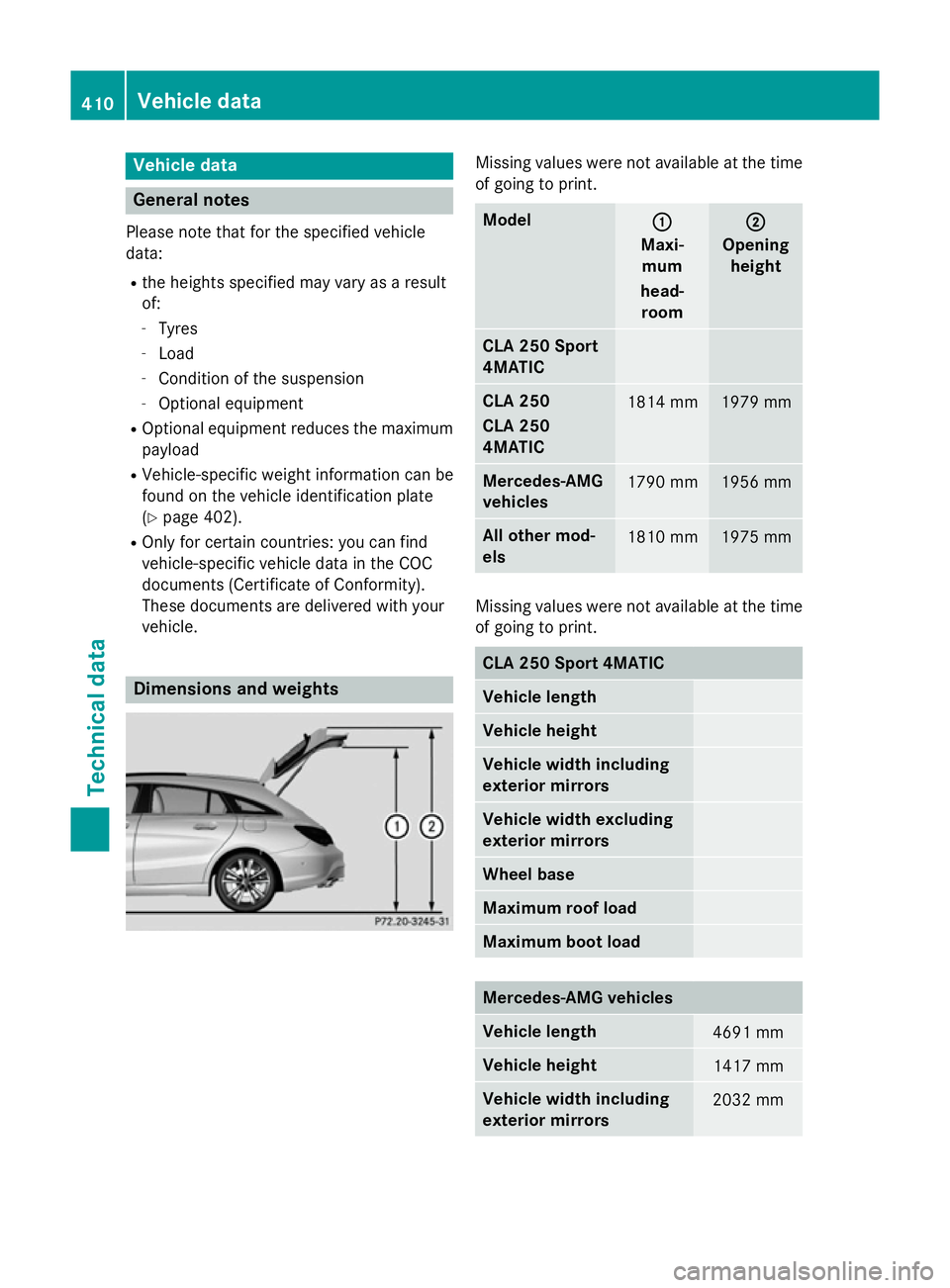
Vehicle data
General notes
Please note that for the specified vehicle
data:
R the heights specified may vary as a result
of:
- Tyres
- Load
- Condition of the suspension
- Optional equipment
R Optional equipment reduces the maximum
payload
R Vehicle-specific weight information can be
found on the vehicle identification plate
(Y page 402).
R Only for certain countries: you can find
vehicle-specific vehicle data in the COC
documents (Certificate of Conformity).
These documents are delivered with your
vehicle. Dimensions and weights Missing values were not available at the time
of going to print. Model
: :
Maxi- mum
head- room ;
;
Opening height CLA 250 Sport
4MATIC
CLA 250
CLA 250
4MATIC
1814 mm 1979 mm
Mercedes-AMG
vehicles
1790 mm 1956 mm
All other mod-
els
1810 mm 1975 mm
Missing values were not available at the time
of going to print. CLA 250 Sport 4MATIC
Vehicle length
Vehicle height
Vehicle width including
exterior mirrors
Vehicle width excluding
exterior mirrors
Wheel base
Maximum roof load
Maximum boot load
Mercedes-AMG vehicles
Vehicle length
4691 mm
Vehicle height
1417 mm
Vehicle width including
exterior mirrors
2032 mm410
Vehicle dataTechnical data
Page 414 of 421
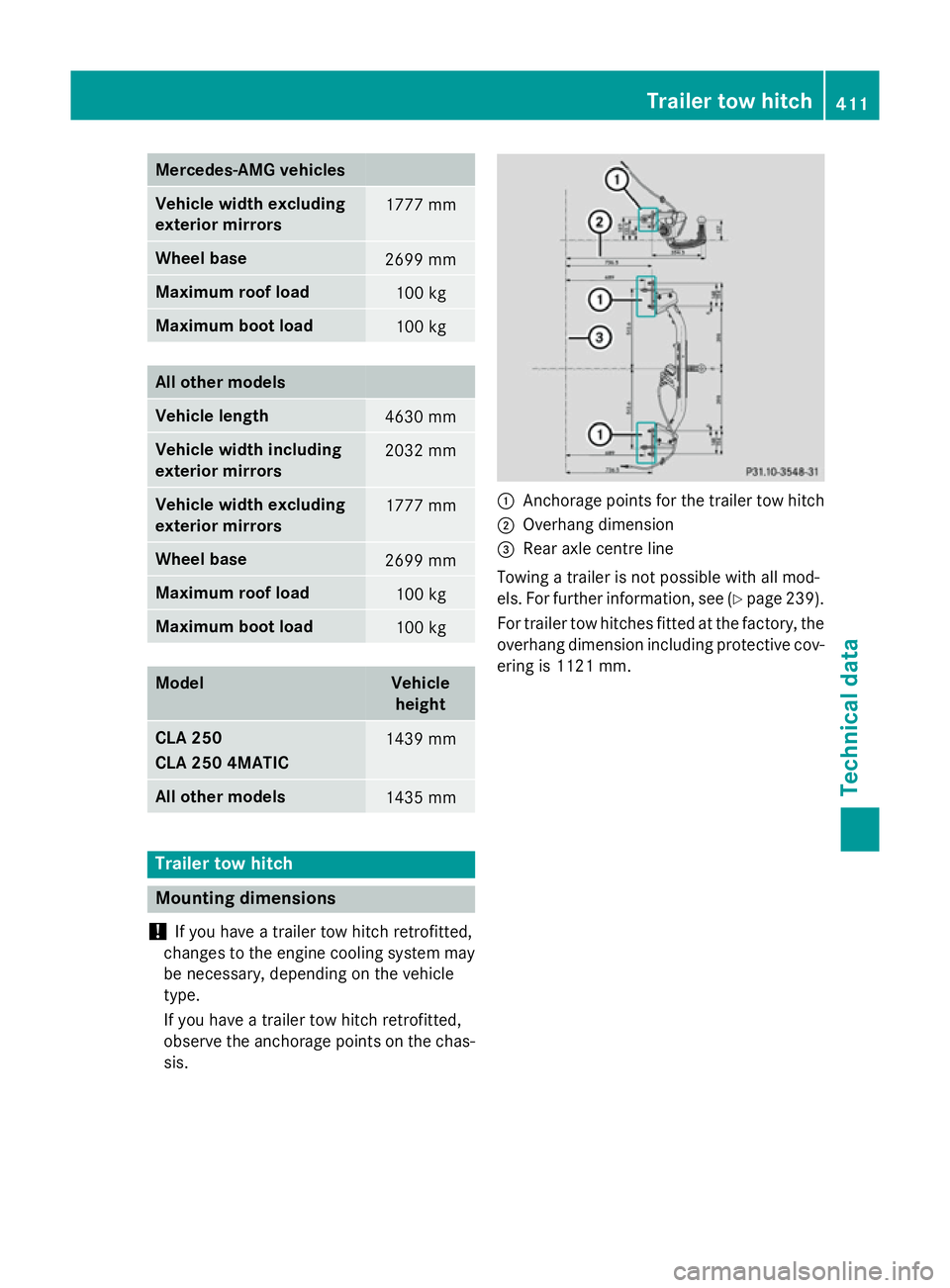
Mercedes-AMG vehicles
Vehicle width excluding
exterior mirrors
1777 mm
Wheel base
2699 mm
Maximum roof load
100 kg
Maximum boot load
100 kg
All other models
Vehicle length
4630 mm
Vehicle width including
exterior mirrors
2032 mm
Vehicle width excluding
exterior mirrors
1777 mm
Wheel base
2699 mm
Maximum roof load
100 kg
Maximum boot load
100 kg
Model Vehicle
height CLA 250
CLA 250 4MATIC
1439 mm
All other models
1435 mm
Trailer tow hitch
Mounting dimensions
! If you have a trailer tow hitch retrofitted,
changes to the engine cooling system may
be necessary, depending on the vehicle
type.
If you have a trailer tow hitch retrofitted,
observe the anchorage points on the chas- sis. :
Anchorage points for the trailer tow hitch
; Overhang dimension
= Rear axle centre line
Towing a trailer is not possible with all mod-
els. For further information, see (Y page 239).
For trailer tow hitches fitted at the factory, the
overhang dimension including protective cov- ering is 1121 mm. Trailer tow hitch
411Technical data Z
Page 415 of 421

Trailer loads
Permissible trailer load, braked (at a minimum gradient-climbing capability of 8%
from a standstill) Towing a trailer is not possible with all models. For further information, see (Y
page 239).
Missing values were not available at the time of going to print. Manual transmission Automatic transmission
CLA 180
1500 kg 1500 kg
CLA 180 d
CLA 200
1500 kg 1500 kg
CLA 200 d
1500 kg 1500 kg
CLA 250
1500 kg
Automatic transmission
CLA 200 d
1500 kg
CLA 220 d
1500 kg
CLA 250 4MATIC
1500 kg
CLA 250 Sport 4MATIC
CLA 220 d 4MATIC
1500 kg
Permissible trailer load, braked (at a minimum gradient-climbing capability of 12%
from a standstill) Towing a trailer is not possible with all models. For further information, see (Y
page 239).
Missing values were not available at the time of going to print. Manual transmission Automatic transmission
CLA 180
1200 kg 1200 kg
CLA 180 d
CLA 200
1400 kg 1400 kg
CLA 200 d
1500 kg 1500 kg
CLA 250
1500 kg412
Trailer tow hitchTechnical data
Page 416 of 421
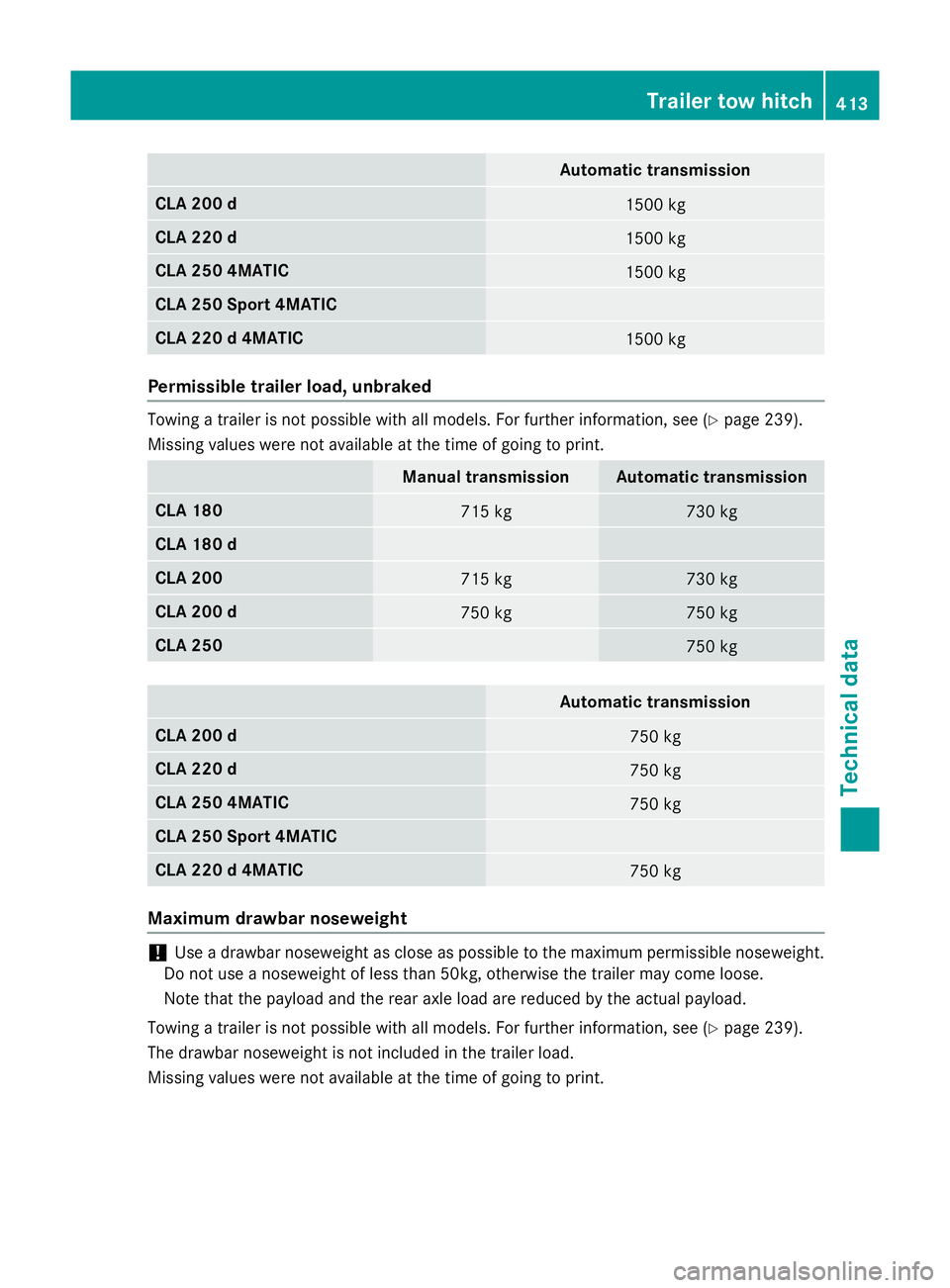
Automatic transmission
CLA 200 d
1500 kg
CLA 220 d
1500 kg
CLA 250 4MATIC
1500 kg
CLA 250 Sport 4MATIC
CLA 220 d 4MATIC
1500 kg
Permissible trailer load, unbraked
Towing a trailer is not possible with all models. For further information, see (Y
page 239).
Missing values were not available at the time of going to print. Manual transmission Automatic transmission
CLA 180
715 kg 730 kg
CLA 180 d
CLA 200
715 kg 730 kg
CLA 200 d
750 kg 750 kg
CLA 250
750 kg
Automatic transmission
CLA 200 d
750 kg
CLA 220 d
750 kg
CLA 250 4MATIC
750 kg
CLA 250 Sport 4MATIC
CLA 220 d 4MATIC
750 kg
Maximum drawbar noseweight
!
Use a drawbar noseweight as close as possible to the maximum permissible noseweight.
Do not use a noseweight of less than 50kg, otherwise the trailer may come loose.
Note that the payload and the rear axle load are reduced by the actual payload.
Towing a trailer is not possible with all models. For further information, see (Y page 239).
The drawbar noseweight is not included in the trailer load.
Missing values were not available at the time of going to print. Trailer tow hitch
413Technical data Z
Page 417 of 421
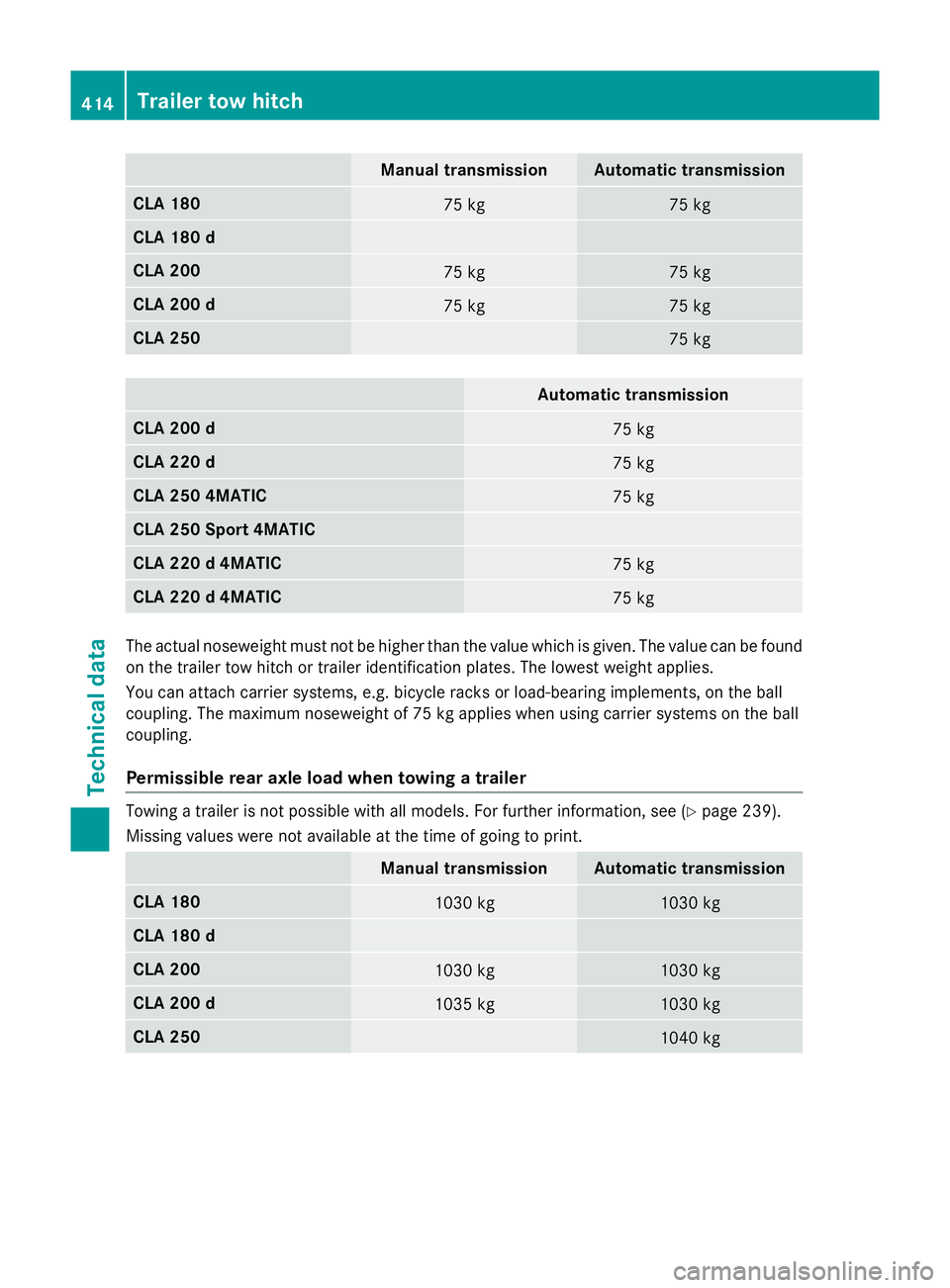
Manual transmission Automatic transmission
CLA 180
75 kg 75 kg
CLA 180 d
CLA 200
75 kg 75 kg
CLA 200 d
75 kg 75 kg
CLA 250
75 kg
Automatic transmission
CLA 200 d
75 kg
CLA 220 d
75 kg
CLA 250 4MATIC
75 kg
CLA 250 Sport 4MATIC
CLA 220 d 4MATIC
75 kg
CLA 220 d 4MATIC
75 kg
The actual noseweight must not be higher than the value which is given. The value can be found
on the trailer tow hitch or trailer identification plates. The lowest weight applies.
You can attach carrier systems, e.g. bicycle racks or load-bearing implements, on the ball
coupling. The maximum noseweight of 75 kg applies when using carrier systems on the ball
coupling.
Permissible rear axle load when towing a trailer Towing a trailer is not possible with all models. For further information, see (Y
page 239).
Missing values were not available at the time of going to print. Manual transmission Automatic transmission
CLA 180
1030 kg 1030 kg
CLA 180 d
CLA 200
1030 kg 1030 kg
CLA 200 d
1035 kg 1030 kg
CLA 250
1040 kg414
Trailer tow hitchTechnical data
Page 418 of 421
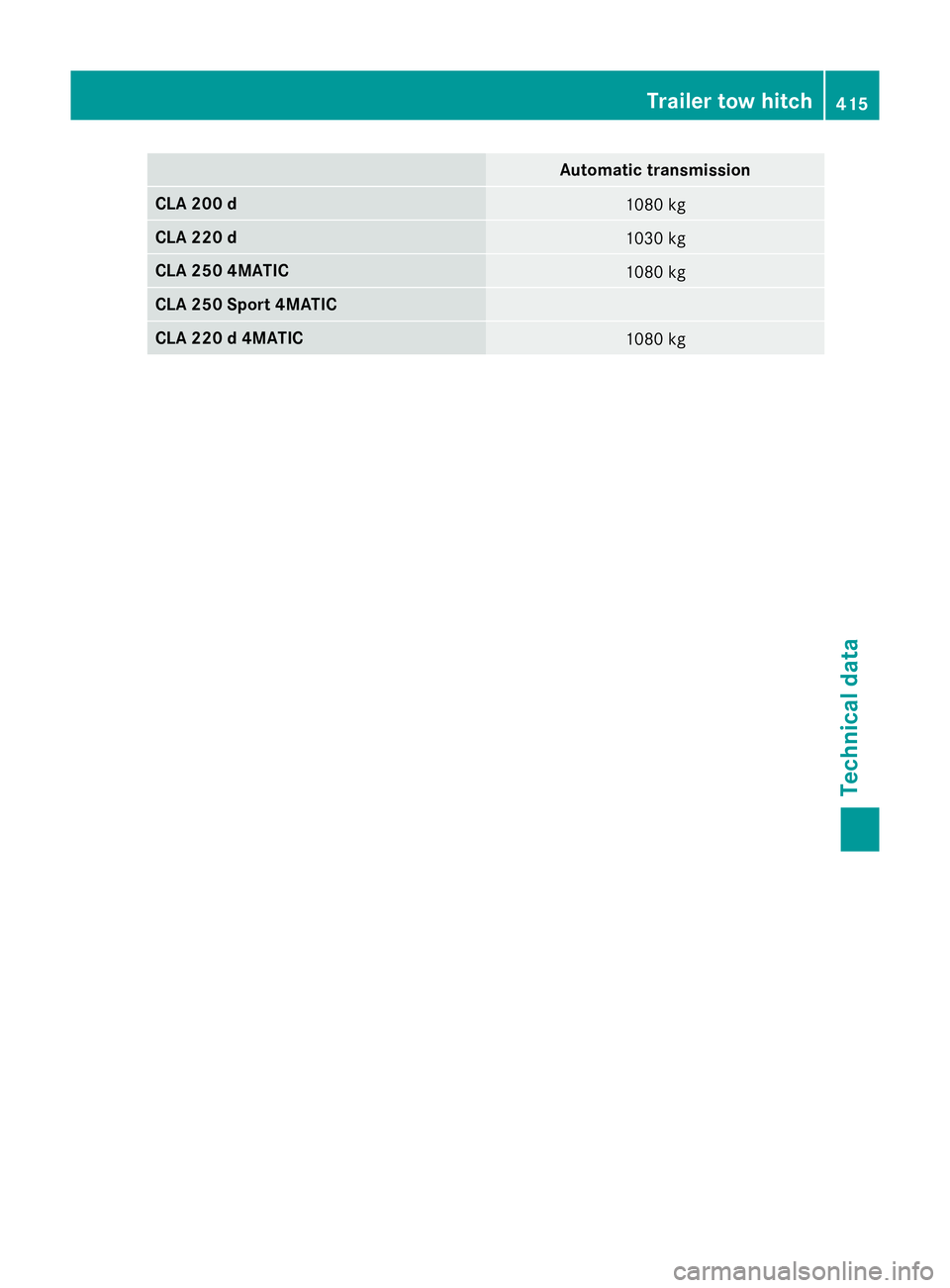
Automatic transmission
CLA 200 d
1080 kg
CLA 220 d
1030 kg
CLA 250 4MATIC
1080 kg
CLA 250 Sport 4MATIC
CLA 220 d 4MATIC
1080 kg Trailer tow hitch
415Technical data Z
Page 419 of 421

416
Page 420 of 421
